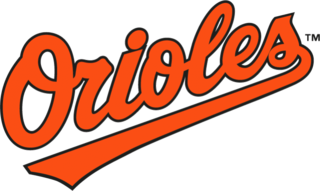Related Research Articles
The 1901 Baltimore Orioles season finished with the Orioles in 5th in the American League with a record of 68–65. The team was managed by John McGraw and played at Oriole Park.

The 2004 Baltimore Orioles season involved the Orioles finishing third in the American League East with a record of 78 wins and 84 losses. The team led Major League Baseball in at bats (5,736) and hits (1,614).

In the 2002 Baltimore Orioles season, the team finished fourth in the American League East with a record of 67 wins and 95 losses.
The 1965 Baltimore Orioles season involved the Orioles finishing third in the American League with a record of 94 wins and 68 losses.
The 1957 Baltimore Orioles season involved the Orioles finishing 5th in the American League with a record of 76 wins and 76 losses.
The 1929 St. Louis Browns season involved the Browns finishing 4th in the American League with a record of 79 wins and 73 losses. This would be the last time the franchise would finish above .500 in a peacetime season until 1960, when they were the Baltimore Orioles.
The Houston Astros' 1991 season was a season in American baseball. It involved the Houston Astros attempting to win the National League West.
The 1895 New York Giants season was the franchise's 13th season. The team finished in ninth place in the National League with a 66–65 record, 21.5 games behind the Baltimore Orioles.
The 1896 New York Giants season was the franchise's 14th season. The team finished in seventh place in the National League with a 64–67 record, 27 games behind the Baltimore Orioles.
In their last season in the American Association, the 1891 Baltimore Orioles finished in fourth place with a record of 71–64. After the season, the AA folded, and the Orioles joined the National League.
The 1892 Baltimore Orioles season was the first season that the professional baseball team known as the Baltimore Orioles competed in the National League, following the demise of the American Association. In a split season schedule, the Orioles finished last in the first half of the season and 10th in the second half. Overall, the team had a record of 46–101, worst in the 12-team National League. The 19th-century Orioles franchise is not the Baltimore Orioles franchise that has competed in the American League since 1954.
The Baltimore Orioles won their first National League pennant in 1894. They won 24 of their last 25 games. After the regular season's conclusion, the Orioles participated in the first Temple Cup competition against the second-place New York Giants. The Orioles lost to the Giants in a sweep, four games to none.
The 1895 Baltimore Orioles season was a season in American baseball. The Orioles finished first in the National League, winning their second straight pennant. However, for the second straight year, they failed to win the Temple Cup, losing to the second-place Cleveland Spiders 4 games to 1.
The Baltimore Orioles won their third straight National League pennant in 1896. After the season, they faced the Cleveland Spiders in the Temple Cup for the second year in a row. After losing 4 games to 1 in 1895, the Orioles swept the Spiders in four straight. The Orioles had now played in the Cup in each of its first three seasons, with this one being their first win.
The 1897 Baltimore Orioles season was a season in American baseball. After three straight first-place finishes, the Orioles slipped to second place with a record of 90–40, 2 games behind the National League-leading Boston Beaneaters. After the season, the two teams met in what would be the final Temple Cup competition, with the Orioles winning 4 games to 1. In all, Baltimore played in all four Temple Cups, losing the first two and winning the last two.
The 1898 Baltimore Orioles season was a season in American baseball. Although there was no Temple Cup after the season, the Orioles still finished second in the National League for the second straight year with a record of 96–53, 6 games behind the Boston Beaneaters. The Orioles set a Major League record which still stands, for the most batters hit by a pitch in a season, with 148.